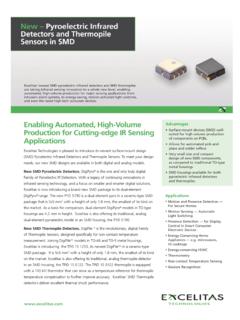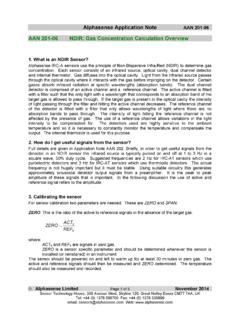Transcription of More Precision. - Micro-Epsilon America
1 More of non contact temperature measurement2 With our eyes we see the world in visible light. Whereas visible light fills only a small part of the radiation spectrum, the invisible light covers most of the remaining spectral range. The radiation of invisible light carries much more additional information. The Infrared Temperature Measurement SystemEach body with a temperature above the absolute zero ( C = 0 Kelvin) emits an electromagnetic radiation from its surface, which is proportional to its intrinsic temperature. A part of this so-called intrinsic radiation is infrared radiation, which can be used to measure a body s temperature.
2 This radiation penetrates the atmosphere. With the help of a lens (input optics) the beams are focused on a detector element, which generates an electrical signal proportional to the radiation. The signal is amplified and, using successive digital signal processing, is transformed into an output signal proportional to the object temperature. The measu-ring value may be shown in a display or released as analog output signal, which supports an easy connection to control systems of the process advantages of non-contact temperature measurement are clear - it supports: - Temperature measurements of moving or overheated objects and of objects in hazardous surroundings- Very fast response and exposure times- Measurement without interreaction, no influence on the measuring object- Non-destructive measurement- Long lasting measurement, no mechanical wearDiscovery of the Infrared RadiationSearching for new optical material William Herschel by chance found the infrared radiation in 1800.
3 He blackened the peak of a sensitive mercury thermometer. This thermometer, a glass prism that led sun rays onto a ta-ble made his measuring arrangement. With this, he tested the heating of different colors of the spectrum. Slowly moving the peak of the blackened thermometer through the colors of the spectrum, he noticed the increas-ing temperature from violet to red. The temperature rose even more in the area behind the red end of the spectrum. Finally he found the maximum temperature far behind the red area. Nowadays this area is called infra-red wavelength area . Infrared SystemThe electromagnetic system with the infrared area used by 1 2 3 4 6 8 10 15 20 301A 100 A 1 m 100 m 1 cm 1m 100 m 100 kmvisiblelightwave lengthwave length in minfraredVHFUVX-rayPhysical BasicsOpticsSensorElectronicsDisplay CObjectWilliam Herschel (1738 - 1822)The Electromagnetic Radiation SpectrumA spectrum in the physical sense is the intensity of a mixture of elec-tromagnetic waves as the function of the wavelength or frequency.
4 The electromagnetic radiation spectrum covers a wavelength area of about 23 decimal powers and varies from sector to sector in origin, creation and application of the radiation. All types of electromagnetic radiation fol-low similar principles of diffraction, refraction, reflection and polarisation. Their expansion speed corresponds to the light speed under normal con-ditions: The result of multiplying wavelength with frequency is constant: f = cThe infrared radiation covers a very limited part in the whole range of the electromagnetic spectrum: It starts at the visible range of about m and ends at wavelengths of approximately 1000 m.
5 3 The following illustration shows the graphic description of the formula de-pending on with different temperatures as parameters. Spectral specific radiation M s of the black body depending on the wavelength The construction of a black body is simple. A thermal hollow body has a small hole at one end. If the body is heated and reaches a certain tem-perature, inside the hollow room a balanced temperature spreads. The hole emits ideal black radiation of this temperature. For each temperature range and application purpose the construction of these black bodies depends on material and the geometric structure. If the hole is very small compared to the surface as a whole, the interference of the ideal state is very small.
6 If you point the measuring device on this hole, you can declare the temperature emitting from inside as black radiation which you can use for calibrating your measuring device. In reality simple arrangements use surfaces, which are covered with pigmented paint and show absorption and emissivity values of 99% within the required wavelength range. Usu-ally this is sufficient for calibrations of real measurements. Radiation Principles of a Black BodyThe radiation law by Planck shows the basic correlation for non-contact temperature measurements: It describes the spectral specific radiation M s of the black body into the half space depending on its temperature T and the wavelength.
7 Drawing of a black body:1 ceramic conduit, 2 heating, 3 conduit made from Al2O3, 4 apertureM s=123410410-210010-410-610-1100101102103 Wavelength in mVisible spectrumLsM W cm2 m6000 K3000 K800 K300 K77 KWavelengths ranging from to 14 m are important for infrared tempe-rature measurement. Above these wavelengths the energy level is so low, that detectors are not sensitive enough to detect them. Physical BasicsIn about 1900 Planck, Stefan, Boltzmann, Wien and Kirchhoff precisely defined the electromagnetic spectrum and established qualitative and quantitative correlations for describing the infrared energy. The Black BodyA black body is a radiator, which absorbs all incoming radiation.
8 It shows neither reflection nor transmissivity. = = 1 ( Absorption, Emissivity)A black body radiates the maximum energy possible at each wavelength. The concentration of the radiation does not depend on angles. The black body is the basis for understanding the physical fundaments of non-contact temperature measurement and for calibrating the infrared thermometers. C = light speedC1 = 10-16 W m C2 = 10-2 K mh = Planck s constant=2 h c2 1 C1 1 5 ehc/ kT-1 5 ec2/ T-1 With rising temperatures the maximum of the spectral specific radiation shifts to shorter wavelengths.
9 As the formula is very abstract it cannot be used for many practical applications. But, you may derive various corre-lations from it. By integrating the spectral radiation intensity for all wave-lengths from 0 to infinite you can obtain the emitted radiation value of the body as a whole. This correlation is called s = T4 [Watt m ] = 10-8 W M-2 K-4 The entire emitted radiation of a black body within the overall wavelength range increases proportional to the fourth power of its absolute tempe-rature. The graphic illustration of Planck s law also shows, that the wave-length, which is used to generate the maximum of the emitted radiation of a black body, shifts when temperatures change.
10 Wien s displacement law can be derived from Planck s formula by differentiation. max T = 2898 m KThe wavelength, showing the maximum of radiation, shifts with increasing temperature towards the range of short wavelengths. 4 Besides the displayed temperature value, the thermometers also support linear outputs such as 0/4-20 mA, 0-10 V and thermocouple elements, which allow an easy connection to control systems of the process ma-nagement. Furthermore, the most of the presently used infrared ther-mometers offer digital interfaces (USB, RS232, RS485) for further digital signal processing and in order to be able to have access to the device parameters.




